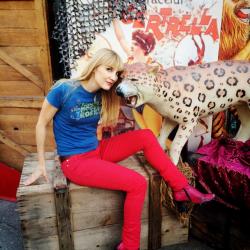One of the many things we have to be proud of in Southern California are the sheer number of original creations that have come out of our land of continuous sunshine and blue skies. The hula hoop, the jacuzzi, and even the Zamboni are all local inventions that have made their mark worldwide, but one local inventor, Leo Fender, actually helped to revolutionize modern music with his innovations. Without him, rock and roll would not have sounded as we know it.
Born in 1909 and raised in Fullerton, Fender opened a radio repair business in 1938 and soon became involved with helping Big Band, Country and Hawaiian-style musicians repair and amplify their acoustic guitars and lap steels. By the mid-1940s he and a partner, Doc Kauffman, had patented a lap steel with an electric pickup and put aside radio repair to focus on the guitar making process. By 1945, Doc had left the business and Leo formed his own company, Fender Electric Instruments. He realized that there would likely be a market for newly developed electric solid body guitars, which were still rare and considered somewhat of a novelty item. Although Fender didn’t invent the first electric solid body guitar, he was the first to recognize its importance and was the first to find a way to mass produce them and make them light, attractive and affordable to the average musician. The Fender Broadcaster, which was soon renamed the Telecaster, was introduced in 1950 and was the first mass-produced electric guitar. In 1951 Fender invented and released the first electric bass, the Precision Bass and in 1953 he put out the iconic Stratocaster. It is no surprise that the first twangs of early rock music were heard a few years later.
Today, the Fender company is based in Corona, CA, about an hour’s drive from Los Angeles and not far from its Fullerton origins. This location has been a working factory since 1998 and manufactures about 400 guitars a day. They offer tours to the public twice daily for a small fee. It is quite an experience to see step by step how these guitars are constructed from simple blocks of wood into instruments that can stir the human soul.
Our tour begins in the Fender Visitor Center, where our friendly guide, David, instructs us to don safety goggles and earphones. The factory is quite dusty and also very loud. In order to hear David’s tour we must turn up the volume and fittingly, amplification, the thing that drove Leo Fender himself, is the order of the day. We enter the actual factory through a long hallway lined with large vintage photos commemorating much of Leo Fender’s life and the history of the Fender guitar. We proceed through many rooms, each specialized departments where segments of each guitar is manufactured by a busy crew of workers. We are led through the Fabrication Room, where pickups are manufactured. While watching the industrious workers busy with each each step we hear a detailed explanation about what is actually happening around us.
It is extremely fascinating to enter the Woodmill and watch planks of alder, ash, maple and more turn into familiar shaped guitar bodies and necks and then see the Sanding Room where these pieces are sculpted and shaped. We are not allowed into the Paint Department, however. We are told that contamination from our clothes could ruin the final product, so we are escorted to the Buff and Polish Room to watch the workers there do their thing.
After watching the work done in Final Assembly we see guitars being tested on old Princeton amps in the Inspection/End of the Line room. We also see workers busy putting together the interior parts of tube amplifiers, but we do not see the cabinets because they are made in Fender’s other factory, located in Ensenada, Mexico. The custom shop is where the master builders work, essentially the star artists of the Fender machine. These are the workers who actually get to sign their product and each have their own individual little work rooms. These people come into work at 4am, so they are already gone for the day as our afternoon tour passes through, but we get to peer into their special work spaces.
All in all our tour lasts a little over an hour, but we are happily sated with knowledge of the guitar manufacturing process. As we walk around the shiny guitars and basses in the exterior showroom, it is easy to remember that each one started out as a humble piece of wood. Invention and creation are two vital parts of Southern California, and as Leo Fender demonstrated just a little bit of either can change an entire art form.
Fender Visitor Center: 301 Cessna Circle, Corona, CA 92880; (951) 898-4040.
The Crossroads of the World, The Bunny Museum, Rubel Castle, Storybook Architecture, Grandma Prisbrey’s Bottle Village, The Nethercutt Museum, Old Trappers Lodge, Dearly Departed Tours, Pamela des Barres Rock-n-roll Tour









Fascinating. Who knew?